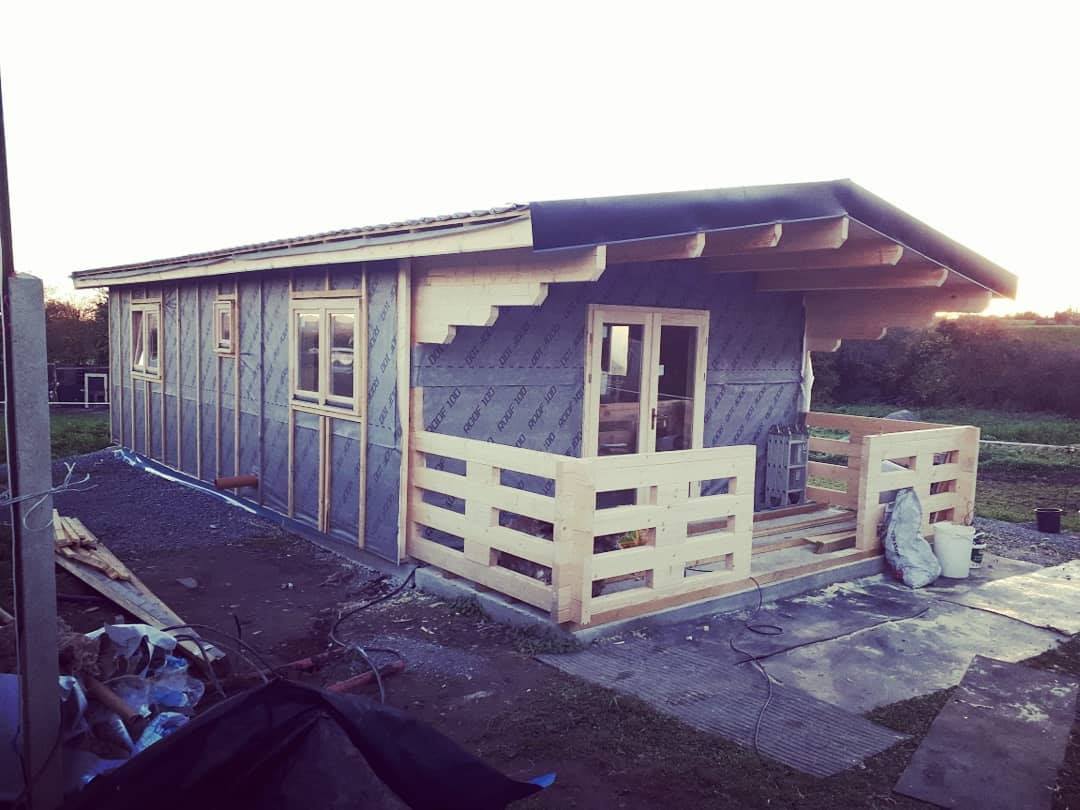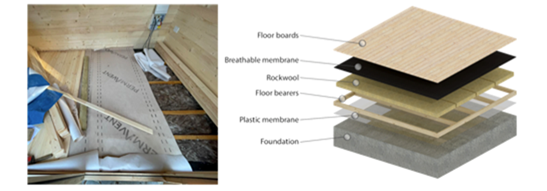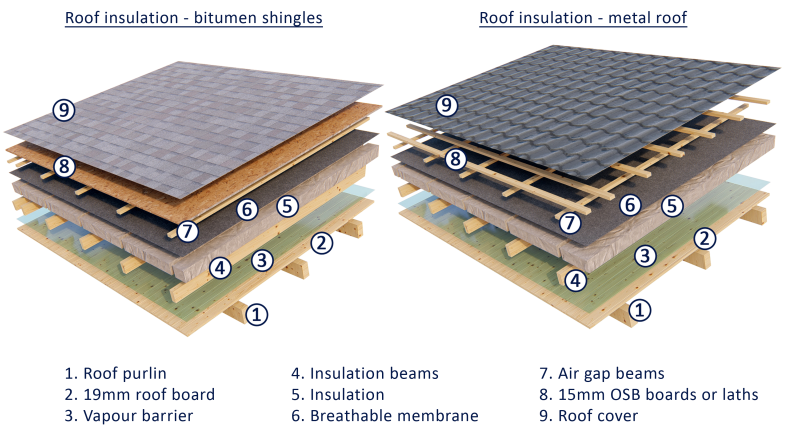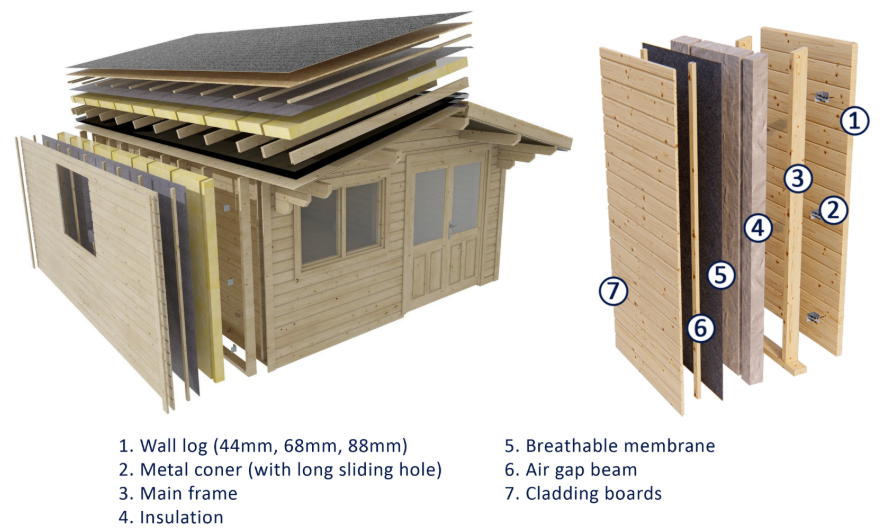If you’ve ever stepped into a backyard shed or cabin on a hot summer day or during a cold winter morning, you’ll know how uncomfortable it can be without proper insulation. That’s where a high-quality insulation kit can make all the difference.

At IdeasWood, we don’t just build beautiful, functional spaces—we make sure they’re livable all year round. Whether you’re setting up an outdoor office, a creative studio, or a guest room, installing an insulation kit is a key step to ensuring energy efficiency, comfort, and long-term durability.
In this article, we’ll explore what insulation kits are, why they matter, and exactly how to install them. We’ll also answer the most common questions from homeowners, DIYers, and builders alike.
What is an insulation kit?
An insulation kit is a ready-to-install package designed to regulate temperature, control moisture, and enhance energy efficiency inside a building. For sheds, studios, and modular homes, these kits are critical to transforming a temporary structure into a functional, long-lasting space.

Think of insulation as your building’s invisible climate control system—working quietly behind the walls and ceiling to keep temperatures stable and energy bills low.
What’s Included in an IdeasWood Insulation Kit?
Every IdeasWood insulation kit is tailored to your specific build.
A typical kit contains:
- High-performance foam or reflective insulation panels
- Ceiling batts or rigid boards
- Moisture-resistant vapour barriers
- Fixing tools and fasteners
- Step-by-step illustrated installation guide
Roof Insulation
Roof insulation kit prepared for specific roof is recommended option to make house warmer or to protect house from the heat which appears from direct sunlight.
We offer two standard roof insulation options: 10 cm & 20 cm.

Wall Insulation
Outside wall insulation kit prepared for specific houses to lower heat losses is supplied with outside decorative boards.
we offer two standard wall insulation options: 10 cm & 20 cm

Floor Insulation
Floor insulation kit prepared for specific house to offer solution to make floor warmer and protect from cold coming from ground.
We offer three standard floor insulation otpions: 5 cm, 10 cm & 15 cm

Why Insulation Matters: Beyond Just Temperature
Many people associate insulation with keeping warm in winter, but it does so much more than that.
Temperature Regulation Year-Round
In Australia and New Zealand, temperature extremes are common. Insulation helps reduce heat gain in summer and heat loss in winter, maintaining a more stable indoor climate.
Energy Savings
When a structure is well-insulated, your air conditioner or heater won’t have to work as hard—leading to lower power bills and a reduced carbon footprint.
Moisture and Mould Protection
Our insulation kits come with vapour barriers to block dampness, helping prevent mould growth, timber rot, and structural damage
Sound Dampening
Insulated walls reduce noise from outside and improve indoor acoustics, which is ideal if you’re setting up a music studio, home office, or guest room.
Property Value & Comfort
A properly insulated space adds both monetary and lifestyle value to your property. Whether you plan to sell, rent, or use it long-term, insulation is a smart investment.
Step-by-Step: How to Install Insulation Kits
We’ve refined our process so anyone—from DIY enthusiasts to first-time builders—can install insulation like a pro.
Roof Insulation
The roof insulation package comprises several components. Some parts are already in the package of your log cabin or chalet, and other components are in the roof insulation package.
Components of roof insulation package:

Instructions:
Step 1:
Lay the plastic membrane (2) over the roof boards (1). This consists of 3 m wide layers and must overlap by 10 cm. Attach it with small nails or staples (not included).
Step 2:
Lay the wooden rafters (3) on the roof. The wooden beams should not be more than 60 cm apart (according to the width of the supplied rock wool). Rafters must be securely attached to the roof using metal corner pieces and screws.
Step 3:
Place the rock wool (4) between the rafters.
Step 4:
The breathable membrane (5) can be stretched over. This consists of 1.5 m-wide layers and must overlap by 5-10cm. Attach it with small nails or staples (not included).
Step 5:
Attach wooden planks (6) to rafters to make a ventilation gap using screws or nails (not included).
Step 6:
Lay OSB boards (7) on the planks and attach with screws (not included). OSB must be cut to length at the construction site.
Step 7:
Cut the excess membrane on the edges of the roof.
Step 8:
Place roof tiles (9) according to instructions on the roofing package.
Step 9:
Install the wind board (8) as shown in the drawing attached.
Floor Insulation
The floor insulation package consists of several parts. Some of the components are already in the package of your log cabin chalet; other parts are in the insulation package.
Components in the floor insulation package:

Instructions:
Step 1:
Make sure you have a flat surface (1) that is fully leveled.
Step 2:
Place the plastic membrane (2) in the foundation. It consists of 3 m wide layers and must overlap by 5-10 cm. Attach it with small nails or staples (not included).
Step 3:
Lay floor bearers (3) as indicated on the drawings of your log cabin or chalet and screw them down (screws not included). The floor bearers should not be more than 60 cm apart (according to the width of the supplied rock wool).
Step 4:
Place the rock wool (4) between the floor bearers.
Step 5:
The breathable membrane (5) can be stretched over it. Pay attention! The desk lay down! This consists of 1.5 m-wide layers that must overlap by ~10 cm. Attach it with small nails or staples (not included).
Step 6:
Install floorboards (6).
Step 7:
Cut the excess membrane on the edges of the floor.
Wall Insulation
Instructions:
Step 1:
Place the wooden insulation beams at 60 cm intervals from the external side of the wall logs. When determining the spacing between beams, adjust according to the width of the insulation material being used. Ensure that the gap between beams is 5-10 mm narrower than the insulation material. This ensures a secure and tight fit, preventing displacement and maintaining thermal efficiency.
Step 2:
Ensure that the perimeter beam is properly positioned around the house. It is recommended to place it on a slab or concrete base to provide sufficient strength and stability for the frame structure. When preparing the foundation, make it at least 125 mm wider around the external wall to accommodate the perimeter beam securely.
Step 3:
Position horizontal beams according to the size of the window and door opening at both the top and bottom. It is essential to create a box frame around all openings, as this will provide the necessary structural support for the installation of windows and doors.

Step 4:
Use metal corners to secure the beams to the wall logs. The spacing between the metal corners should be approximately 1.2-1.6 m, depending on the building structure. Do not screw the beams directly to the wall logs, as the natural settling of the logs could cause wall deformation.
Step 5:
Ensure that there is at least 40 mm (4 cm) of clearance between the top of the beam and the roof. This gap is necessary to allow for the natural settling of the walls, preventing structural stress and deformation.
Step 6:
Insert the insulation material between the insulation beams. Ensure that it is installed tightly and without gaps to maximize thermal efficiency and prevent heat loss.
Step 7:
When installing insulation in a large building, consider installing insulation one wall at a time if weather conditions are a concern. After completing each wall, immediately install a breathable membrane to protect the insulation material from exposure to moisture and adverse weather conditions.
Step 8:
Stretch the breathable membrane layer approximately over the beams. It should be installed in one 1.5 m wide layer, overlapping by approximately 10-15 cm, as recommended in the breathable membrane specifications. Attach it using staples. It is recommended to use tape to secure the overlapping lines and the areas where staples were used.
Step 9:
Cut the breathable membrane if necessary to fit the required areas. Utilize remaining membrane sheets where possible to minimize waste while ensuring full coverage and proper protection.
Who Needs an Insulation Kit?
If you’re building any enclosed space for more than seasonal storage, insulation should be part of your plan.
You need an insulation kit if you’re:
- Turning a shed into a home office
- Converting a modular home for year-round use
- Creating a tiny home, backyard cabin, or site accommodation
Common Questions About Insulation Kits
Is it easy to install?
Yes—especially with our pre-cut kits. All you need are basic tools, and the guide walks you through each step.
Can I upgrade insulation later?
Retrofitting is possible, but more difficult. It’s far more efficient to insulate during the initial build.
How long does it last?
Most insulation materials last 20–30 years or more when installed properly.
Does it add value to my space?
Definitely. Comfort, energy savings, and resale value all increase with a well-insulated structure.

Justinas Teliuk
CEO
Thanks for being a valued part of our journey. As we continue to expand our offerings, I’ve put dedicated thought into our latest focus—insulation kits for sheds, log cabins, and modular homes. With varying climates and customer preferences in mind, we’re exploring both standard and premium (fully insulated) solutions to support comfort and energy efficiency year-round.
I’d greatly appreciate your feedback, ideas, or any insights you may have regarding these developments.
Looking forward to hearing your thoughts!
Warm Regards
